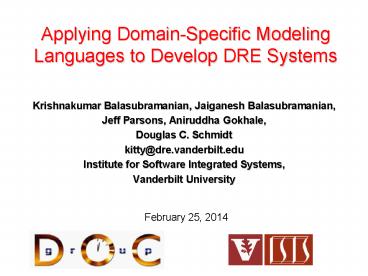Applying Domain-Specific Modeling Languages to Develop DRE Systems PowerPoint PPT Presentation
Title: Applying Domain-Specific Modeling Languages to Develop DRE Systems
1
Applying Domain-Specific Modeling Languages to
Develop DRE Systems
- Krishnakumar Balasubramanian, Jaiganesh
Balasubramanian, - Jeff Parsons, Aniruddha Gokhale,
- Douglas C. Schmidt
- kitty_at_dre.vanderbilt.edu
- Institute for Software Integrated Systems,
- Vanderbilt University
2
Overview
- Deployment Configuration of Component-based
systems - Introduction
- Challenges
- Platform-Independent Component Modeling Language
(PICML) - Future work
3
Overview of Component Middleware
Write Code That Reuses Code
- Components encapsulate application business
logic - Components interact via ports
- Provided interfaces, e.g.,facets
- Required connection points, e.g., receptacles
- Event sinks sources
- Attributes
- Containers provide execution environment for
components with common operating requirements - Components/containers can also
- Communicate via a middleware bus and
- Reuse common middleware services
4
Motivation for Deployment Configuration
- Goals
- Ease component reuse
- Build complex applications by assembling existing
components - Standardize deployment of applications into
heterogeneous domains - Separation of concerns
- Component development
- Application assembly
- Application deployment
- Application configuration
- Middleware configuration
5
OMG Deployment Configuration Spec
- Specification defines deployment of
component-based applications - Intended to replace Packaging Deployment
chapter of CCM specification - Meta-information is captured using XML
descriptors - Platform Independent Model (PIM)
- Defined in two dimensions
- Data models vs. management (run-time) models
- Component software vs. target vs. execution
6
Platform-independent Model (PIM) Dimensions
- Modeling view-points
- Conceptual, logical, physical view-point
- Platform-independent model
- Conceptual logical viewpoint of deployment
configuration - Defined in two-dimensions
PIM Data Model Run-time Model
Component Software Meta-data to describe component based applications and their requirements Interfaces to browse, store and retrieve such meta-data
Target Meta-data to describe heterogeneous distributed systems their capabilities Interfaces to collect retrieve such meta-data and commit resources
Execution Meta-data to describe a specific deployment of an application into a distributed system Prepare environment, Execute on target to Deployment plan, manage lifecycle
7
PIM Mapping to CCM
- Physical viewpoint
- Mapping from PIM to platform specific model (PSM)
for CCM - Set of transformations
- T1 ? PIM to PSM for CCM
- T2 ? PSM to
- PSM for IDL
- PSM for XML
- Set of mapping rules
- M1 ? PSM to IDL
- M2 ? PSM to XML schema
8
Deployment Configuration Activities
- Descriptors are passive entities
- Manipulated by Actors
- Different Stages
- Development
- Developer
- Assembler
- Packager
- Target
- Domain Administrator
- Deployment
- Repository Administrator
- Planner
- Executor
- Actors are abstract
9
Configuration Challenges
- Context
- Configuring composing component-based
applications using XML meta-data
- Problem
- Meta-data split across multiple XML descriptors
- Complex inter-dependencies between descriptors
- XML is error-prone to read/write manually
- No guarantees about semantic validity (only
syntactic validation possible) - If meta-data is wrong, what about the application?
10
Platform-Independent Component Modeling Language
- Solution
- PlCML
- Developed in Generic Modeling Environment (GME)
- Core of Component Synthesis using
Model-Integrated Computing (CoSMIC) toolchain - Capture elements dependencies visually
- Define static semantics using Object Constraint
Language (OCL) - Define dynamic semantics via model interpreters
- Also used for generating domain specific
meta-data - Correct-by-construction
11
Steps in a typical usage of PICML (1/2)
- Define component types
- Import/Export IDL
- Define implementation artifacts
- External libraries, individual component
libraries - Define component implementations
- Monolithic components
- Assembly-based components
- Assembly of assemblies
12
Steps in a typical usage of PICML (2/2)
- Define component packages
- Configure (previously defined) component packages
- Define deployment target
- Can be done as a decoupled activity
- Define deployment plan
- Place components on different nodes of the target
13
Hierarchical Composition
- Six streams of image data
- System incomprehensible
- Hierarchical composition
- Reason about system at multiple levels of
abstraction
14
Types Of Meta-data generated by PICML
- Component Interface Descriptor (.ccd)
- Describes the interface, ports, properties of a
single component - Implementation Artifact Descriptor (.iad)
- Describes the implementation artifacts (e.g.,
DLLs, OS, etc.) of a single component - Component Package Descriptor (.cpd)
- Describes multiple alternative implementations of
a single component - Package Configuration Descriptor (.pcd)
- Describes a specific configuration of a component
package - Component Implementation Descriptor (.cid)
- Describes a specific implementation of a
component interface - Contains component inter-connection information
- Component Deployment Plan (.cdp)
- Plan which guides the actual deployment
- Component Domain Descriptor (.cdd)
- Describes the target domain of deployment
- Component Packages (.cpk)
- Aggregation of all of the above
15
Example Application RobotAssembly
Conveyor Power Switching Unit
Conveyor Drive System
Management Work Instructions
Radio
Discretes
Intrusion Alarm
Pallet Present
Switches
Pallet Release Switch
Human Machine Interface
Watch Setting Manager
Pallet Conveyor Manager
Off Enable
Off Enable Fast
Assembly Area Intrusion
Robot Manager
Robot in Work Area
Control Station
Storage Device Controller
Disk Storage
Clock Handler
16
RobotAssembly in PICML
17
Example output for RobotAssembly
lt!-Component Implementation Descriptor(.cid)
associates components with impl. artifacts--gt
ltDeploymentComponentImplementationDescriptiongt
ltUUIDgtFB9D7161-1765-4784-BC1D-EA9EAAB3ED2Alt/UUIDgt
ltimplements href"RobotManager.ccd" /gt
ltmonolithicImplgt ltprimaryArtifactgt
ltnamegtRobotManager_execlt/namegt
ltreferencedArtifact href"RobotManager_exec.iad"
/gt lt/primaryArtifactgt ltprimaryArtifactgt
ltnamegtRobotManager_stublt/namegt
ltreferencedArtifact href"RobotManager_stub.iad"
/gt lt/primaryArtifactgt ltprimaryArtifactgt
ltnamegtRobotManager_svntlt/namegt
ltreferencedArtifact href"RobotManager_svnt.iad
/gt lt/primaryArtifactgt lt/monolithicImplgt lt/Dep
loymentComponentImplementationDescriptiongt
18
Example Application UAV
19
UAV in PICML
20
Concluding Remarks
- PICML
- Model component-based systems
- Allows design-time validation of systems
- Generates component meta-data
- Future work
- Scalability issues
- Traditional system analysis
- Complete system generation aka Middleware
Compiler - Generate optimized systems aka Optimizing
Middleware Compiler - Available as open-source
- http//cvs.dre.vanderbilt.edu (CoSMIC)

